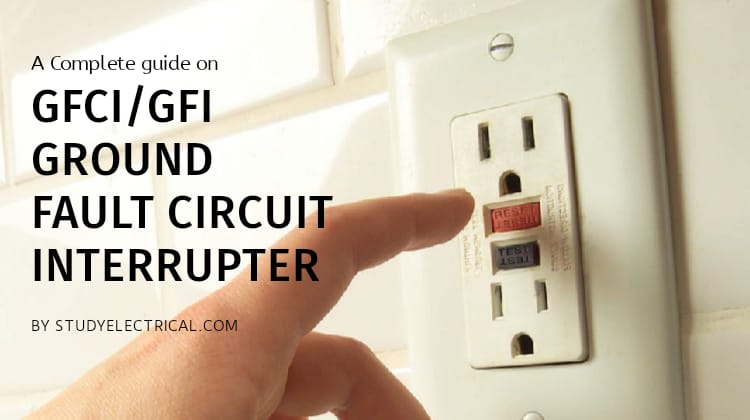Ground Fault Circuit Interrupter Troubleshooting: Easy Fixes and Tips
Ground Fault Circuit Interrupters (GFCIs) are vital for home safety. They protect you from electrical shocks.
Understanding how to troubleshoot them is essential for every homeowner. GFCIs can sometimes trip or fail, causing inconvenience or safety hazards. Knowing the common problems and solutions can save you time and worry. This guide will help you identify issues with your GFCI and provide easy steps to fix them.
By the end, you’ll feel more confident in handling these devices and ensuring your home’s electrical safety. Let’s dive into the basics of GFCI troubleshooting to keep your home safe and sound.
Introduction To Gfci
GFCI troubleshooting helps identify and fix ground fault issues in electrical circuits. It ensures safety by preventing shocks. Understanding how GFCI works can save lives and protect homes.
A Ground Fault Circuit Interrupter (GFCI) is a critical device for home safety. It helps protect people from electric shock. Understanding its function and importance can help maintain a safe living environment.What Is A Gfci?
A GFCI, or Ground Fault Circuit Interrupter, is a special electrical outlet. It detects ground faults and shuts off the power. This happens quickly, in less than a second. Ground faults occur when electricity takes an unintended path to the ground. This can happen through water or a person. GFCIs sense these faults and act to prevent harm.Importance Of Gfci
GFCIs are vital for preventing electric shocks. They are especially important in wet areas. Kitchens, bathrooms, and outdoor outlets should have GFCIs. They save lives by cutting off power during faults. This reduces the risk of shock, burns, or fire. Ensuring GFCIs work correctly is crucial for home safety. “`
Credit: studyelectrical.com
Common Gfci Problems
Ground Fault Circuit Interrupters (GFCIs) are essential for safety. They protect against electric shock and prevent electrical fires. But sometimes, they can have issues. Below, we explore some common problems with GFCIs.
Tripping Issues
GFCIs often trip for various reasons. Some of these reasons are easy to fix. Here are some common causes:
- Faulty wiring
- Moisture in the outlet
- Overloading of the circuit
- Worn-out GFCI outlet
Check for visible damage or loose wires. Ensure that no water has entered the outlet. If the problem persists, the GFCI might need replacement.
Reset Failures
If your GFCI outlet does not reset, it can be frustrating. Here are some possible reasons for reset failures:
- The outlet is damaged
- The circuit breaker is tripped
- There is a short circuit
- Loose connections in the wiring
First, press the reset button firmly. If it still does not reset, check the circuit breaker. Ensure all connections are tight. Replace the outlet if needed.
| Problem | Possible Cause | Solution |
|---|---|---|
| Tripping | Moisture | Dry the outlet |
| Reset Failure | Damaged outlet | Replace outlet |
| Tripping | Faulty wiring | Check and fix wiring |
Tools Needed For Troubleshooting
When troubleshooting Ground Fault Circuit Interrupters (GFCIs), having the right tools is crucial. Proper tools ensure accurate diagnostics and a smooth repair process. Below are some essential tools and safety gear needed to effectively troubleshoot GFCIs.
Essential Tools
A multimeter is a must-have for testing electrical circuits. It helps measure voltage, current, and resistance. A circuit tester is also important. It checks if the circuit is live or not. Wire strippers and cutters are necessary for working with wiring. These tools ensure clean cuts and proper wire stripping.
Another essential tool is a screwdriver set. Different sizes and types are needed for various screws. A voltage tester provides quick voltage checks. It is handy for ensuring circuits are dead before working on them. Additionally, a GFCI tester is vital. This specialized tool tests GFCI outlets for proper functionality.
Safety Gear
Safety is paramount when dealing with electrical systems. Always wear insulated gloves. They protect against electric shocks. Safety goggles are essential. They shield your eyes from debris and sparks.
A rubber mat is also crucial. Stand on it while working to avoid grounding yourself. Ensure the area is dry to prevent slips and falls. Wearing proper footwear with rubber soles adds another layer of protection. Lastly, have a first aid kit nearby. Be prepared for any minor injuries that might occur.
Identifying The Problem
Ground Fault Circuit Interrupters (GFCIs) are essential for electrical safety. They help prevent electric shocks. But sometimes, they can trip or malfunction. Identifying the problem can save you time and ensure your safety.
Visual Inspection
Start with a visual inspection. Look at the GFCI outlet. Check for visible damage. Cracks, burn marks, or discoloration are signs of trouble.
Make sure the reset button is not popped out. If it is, it indicates a trip. Inspect the faceplate and screws. Ensure they are tight and secure.
Check the surrounding area. Are other outlets or appliances affected? Sometimes, the problem extends beyond the GFCI outlet.
Testing Procedures
After a visual inspection, perform testing procedures. Press the test button on the GFCI outlet. The reset button should pop out. If it does, the GFCI is working.
If the reset button does not pop out, the GFCI might be faulty. Use a GFCI tester. Plug it into the outlet. The tester will indicate if the GFCI is functioning.
Next, check the circuit breaker. Sometimes, the breaker trips instead of the GFCI. Reset the breaker if necessary.
If the GFCI still does not work, call a professional electrician. Electrical issues can be dangerous. Do not attempt complex repairs yourself.
Fixing Tripping Issues
Experiencing frequent tripping with your Ground Fault Circuit Interrupter (GFCI) can be frustrating. Identifying and fixing the issue can restore functionality and safety to your electrical system. This guide covers common causes and solutions for tripping issues.
Overload Solutions
One common cause of GFCI tripping is an overloaded circuit. Here are some steps to address this:
- Identify high-power devices: Check which devices draw the most power.
- Distribute the load: Spread out these devices across multiple circuits.
- Check wiring: Ensure wiring can handle the load.
Consider using a table to determine the power draw:
| Device | Power (Watts) |
|---|---|
| Microwave | 1200 |
| Refrigerator | 800 |
| Toaster | 1000 |
Ground Fault Solutions
Another cause of GFCI tripping is a ground fault. Here’s how to troubleshoot:
- Inspect appliances: Check for damaged cords or plugs.
- Test outlets: Use a GFCI tester to check if outlets are grounded properly.
- Replace faulty equipment: Replace any equipment that has a ground fault.
To summarize, addressing overload and ground faults can resolve GFCI tripping issues. Regular checks and maintenance will ensure your GFCI operates smoothly.

Credit: www.youtube.com
Resolving Reset Failures
Ground Fault Circuit Interrupters (GFCIs) are essential for electrical safety. They protect you from electrical shocks. Sometimes, GFCIs fail to reset. Understanding the causes helps you fix the problem. This section covers common issues, such as button malfunctions and electrical supply issues. Follow these steps to troubleshoot and resolve reset failures.
Button Malfunctions
GFCI reset buttons can fail. Dirt or debris might block the button. Clean the button area carefully. Use a small brush or compressed air. Press the button again. If it still doesn’t work, the button might be broken.
Inspect the button for physical damage. Look for cracks or other signs of wear. If damaged, replace the GFCI outlet. Follow these steps to replace the outlet:
- Turn off the power at the circuit breaker.
- Unscrew the outlet cover and remove the GFCI outlet.
- Disconnect the wires from the old outlet.
- Connect the wires to the new GFCI outlet. Match the wire colors.
- Screw the new outlet into place and replace the cover.
- Turn the power back on and test the new GFCI outlet.
Electrical Supply Issues
Sometimes, GFCI reset failures stem from electrical supply problems. These problems could be a tripped circuit breaker or a blown fuse. Check your home’s circuit breaker panel.
Follow these steps to identify and fix electrical supply issues:
- Look for any tripped breakers. Reset them if needed.
- Check for blown fuses. Replace any blown fuses.
- Ensure the GFCI outlet is properly connected to the electrical supply.
- Inspect wiring for damage. Loose or damaged wires can cause problems.
If the GFCI outlet still fails to reset, contact a licensed electrician. They can diagnose and fix complex electrical issues.
Preventative Maintenance
Preventative maintenance is crucial for ensuring the longevity and efficiency of Ground Fault Circuit Interrupters (GFCIs). Regular upkeep helps in identifying potential issues before they become major problems. It also ensures the safety and reliability of your electrical systems. Below are some key aspects of preventative maintenance for GFCIs.
Regular Testing
Regular testing of GFCIs is essential. Press the “Test” button on the device. This should cut off the power supply. If it doesn’t, the GFCI may be faulty. Reset the device by pressing the “Reset” button. Conduct these tests monthly to ensure proper functionality.
Environment Considerations
Environment plays a significant role in GFCI performance. Moisture and dust can affect their efficiency. Install GFCIs in dry and clean locations. Check for any signs of wear or corrosion. Replace damaged units immediately. Use protective covers in areas prone to moisture. This prolongs the life of the GFCI.
When To Call A Professional
Call a professional if your Ground Fault Circuit Interrupter (GFCI) keeps tripping or won’t reset. Electrical issues can be dangerous and require expert handling.
Figuring out Ground Fault Circuit Interrupter (GFCI) issues can be tricky. Sometimes, you can fix small problems yourself. But other times, it’s best to call a professional. Knowing when to call can keep you safe. It can also save time and money.Complex Electrical Issues
Some electrical issues are too complex for most people. You may face wiring problems. Or there might be issues with the electrical panel. These tasks need special skills. A professional electrician has the training. They understand the risks. They can solve these problems safely.Safety Concerns
Safety is always a priority. Working with electricity can be dangerous. If you are unsure, do not take the risk. Call a professional. They have the right tools. They know the best practices. They can ensure your home remains safe. “`
Credit: www.youtube.com
Frequently Asked Questions
What Is A Ground Fault Circuit Interrupter (gfci)?
A GFCI is a device that protects you from electrical shock. It detects ground faults and quickly cuts off power.
How To Test A Gfci Outlet?
Press the “Test” button on the GFCI outlet. The “Reset” button should pop out, indicating it works.
Why Does My Gfci Outlet Keep Tripping?
Frequent tripping can be due to ground faults, moisture, or a faulty device plugged in.
Can A Gfci Outlet Go Bad?
Yes, like any device, GFCI outlets can wear out over time and may need replacement.
How To Reset A Tripped Gfci Outlet?
Press the “Reset” button on the GFCI outlet. It should click and restore power.
Conclusion
Troubleshooting a Ground Fault Circuit Interrupter can be simple with the right steps. Always start by checking the reset button. Ensure the outlet is not overloaded. Test the GFCI regularly to prevent issues. If problems persist, consider professional help. Proper maintenance ensures safety and reliability.
Remember, a functioning GFCI protects against electrical hazards. Keep your home safe by staying vigilant. Your attention to detail makes a difference. Happy troubleshooting!






